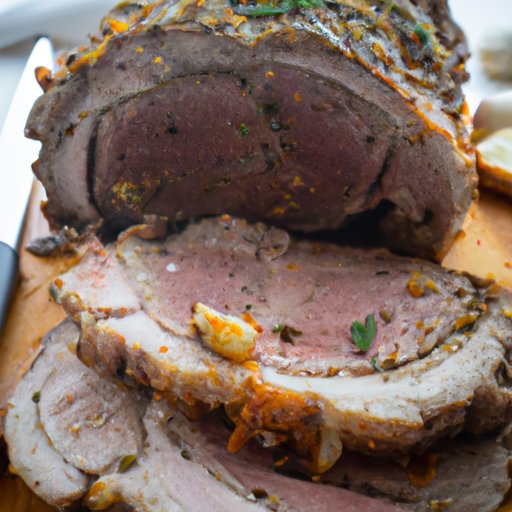
I. Introduction
Rib roast is a classic holiday dish that can be challenging to cook for some. Cooking it to perfection requires proper preparation, seasoning, and roasting techniques. In this article, we will provide tips, tricks, and a foolproof recipe to help you cook a delicious rib roast every time. Whether it’s for special occasions or a simple family dinner, you’ll be a master at cooking rib roast by the end of this guide.
II. The Ultimate Guide to Cooking Rib Roast: Tips and Tricks
The importance of selecting the right cut of meat cannot be overstated. A prime rib roast, also known as a standing rib roast, is the preferred cut for the perfect holiday meal. It is well-marbled and typically has 2-7 ribs attached, depending on the size. When shopping, you might also want to consider the grade of meat. USDA Prime and Choice are the best options for rib roast.
Seasoning the meat is an important step to creating an exceptional rib roast. It is best to keep it simple with kosher salt and freshly cracked black pepper. Rub the seasoning onto the meat for a few hours or overnight to allow the flavors to penetrate deeply.
When it comes to cooking temperature and techniques, a low and slow approach is the way to go. Preheat your oven to 350°F and roast the meat for around fifteen minutes per pound. It is important to use a meat thermometer to check the internal temperature. For rare, the meat should reach 120-125°F; for medium-rare, it should reach 130-135°F; for medium, it should reach 140-145°F.
Allow the roasted meat to rest at least twenty minutes before carving. This will help to keep the juices inside and make it moist and tender. When ready, carve the meat away from the bones and slice it thinly across the grain.
III. From Oven to Table: Simplifying the Process of Rib Roast Preparation
When preparing the rib roast, it is essential to bring the meat to room temperature. Before seasoning it, take it out of the refrigerator for at least two hours. Trussing and tying the roast will help it cook evenly, and it will also create an attractive presentation.
In terms of side dishes, potato gratin, roasted vegetables, and Yorkshire pudding pair well with rib roast. A robust red wine like Cabernet Sauvignon is the perfect complement.
IV. A Foolproof Recipe for Perfectly Cooked Rib Roast Every Time
Ingredients:
- 1 (4-6 pound) prime rib roast
- Kosher salt and freshly cracked black pepper, to taste
Instructions:
- Remove the rib roast from the refrigerator and let it come to room temperature, approximately two hours.
- Preheat the oven to 350°F.
- Season the meat heavily with kosher salt and freshly cracked black pepper, rubbing it in well.
- Place the roast in a roasting pan and roast for fifteen minutes per pound, checking the internal temperature with a meat thermometer.
- For rare, the meat should reach 120-125°F; for medium-rare, it should reach 130-135°F; for medium, it should reach 140-145°F.
- Remove the roast from the oven and cover it loosely with foil. Let it rest for at least twenty minutes before carving.
- Carve the roast away from the bones and slice it thinly across the grain.
V. Spice Up Your Holiday Dinner with a Delectable Rib Roast Recipe
For a twist on the classic recipe, try using a rub or glaze to add flavors to your rib roast. Fresh herbs like rosemary, thyme, or parsley can add a fragrant aroma to the meat. A simple honey-mustard glaze can add a touch of sweetness to balance out the savory flavors of the meat.
You can also experiment with incorporating additional herbs and spices into the meat seasoning. Garlic powder, onion powder, and smoked paprika are all excellent choices.
VI. How to Select, Prep, and Cook a Rib Roast for an Unforgettable Meal
When selecting a rib roast, it is essential to assess the grade and tenderness of the meat. USDA Prime and Choice are the best options for rib roast as these meats are well-marbled and have excellent flavor.
As mentioned earlier, trussing the meat is crucial to even cooking. It will also ensure that your roast has an elegant presentable shape. Before seasoning, let the meat come to room temperature for a few hours to allow it to cook evenly.
The principles of wine pairings are the same: full-bodied red wines such as Cabernet Sauvignon, Pinot Noir, or Merlot go well with rib roast. However, it all comes down to personal preference and taste.
VII. Master the Art of Cooking Rib Roast: A Step-by-Step Guide for Beginners
There are different types of rib roasts, including the boneless rib roast, the standing rib roast (also called prime rib), and the rolled rib roast. Choosing the right cut for your occasion is critical.
Preparing and cooking a rib roast can seem daunting, but it is an easy process if you follow the step-by-step approach. Begin by seasoning the meat with kosher salt and freshly cracked black pepper. Then place it in the oven and roast it slowly until the internal temperature reaches your desired level of doneness.
Once cooked, let it rest before carving it and serving it along with your preferred side dishes and wine.
VIII. Conclusion
We hope this ultimate guide to cooking rib roast has provided you valuable information and suggestions on preparing a delicious meal for your family or guests. Remember to choose the right cut of meat, season it well, roast it at the proper temperature, and let it rest before carving. With our foolproof recipe and helpful tips, you’re sure to have a perfectly cooked rib roast every time!
Don’t be afraid to experiment with different herbs, spices, and glazes to make your holiday meal unique. Try it for yourself and discover why rib roast is such a popular and beloved dish among families and friends around the world.




